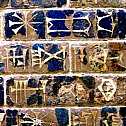 With over 7,000 known languages spoken around the world today, it may seem fruitless for scholars to have spent the past 90 years creating a dictionary for a language that has been extinct for nearly 2,000 years. Hold on; Let’s look at the reasons for the immense effort, and form our judgements afterwards.
With over 7,000 known languages spoken around the world today, it may seem fruitless for scholars to have spent the past 90 years creating a dictionary for a language that has been extinct for nearly 2,000 years. Hold on; Let’s look at the reasons for the immense effort, and form our judgements afterwards.
Originally modeled on the Oxford English Dictionary, the recently completed Chicago Assyrian Dictionary, or CAD, is a twenty-one-volume reference of ancient Mesopotamian dialects. Consisting of 28,000 words, the CAD offers an in depth study of the cuneiform script – one of the first known writing systems, with cuneiform deriving from the Latin cuneus, “wedge-shaped,” after the triangular shapes of the script (see the accompanying image for an example.)
(In related news, a lost, legendary dictionary was recently discovered. Find out where, and what language it may help to revive, here.)
When James Henry Breasted began compiling the dictionary’s content in 1921, all evidence, including preserved clay tablets and stone inscriptions, pointed to the Assyrian language as the common spoken word of the Sumerians. However, as further research proved, writing samples showed that the Akkadian language, part of the Afroasiatic language family, was probably more commonly spoken throughout the culture – deeming the dictionary’s name somewhat misleading.
According to editor in charge, Martha T. Roth, “Every term, every word becomes a window into the culture.” Words such as kalu meaning “detain, keep in custody, hold back” and di’nu, “case,” suggest that the language was a vital tool for the formation of the first recorded laws and government — anywhere. In addition, repeated reference in written records to ardu, meaning “slave,” provides evidence that slavery was common in ancient civilizations.
The language reflects the beginnings of land irrigation and the mass shipment of cultivated goods. One of the world’s earliest known works of literature, the Epic of Gilgamesh, is a series of Sumerian legends and poetry originally inscribed on clay tablets in the Akkadian language. In other words, if we understand the way that the world’s pioneers of literature, agriculture, and finance structured their thoughts, perhaps we can better understand ourselves. Do you agree? Let us know.














